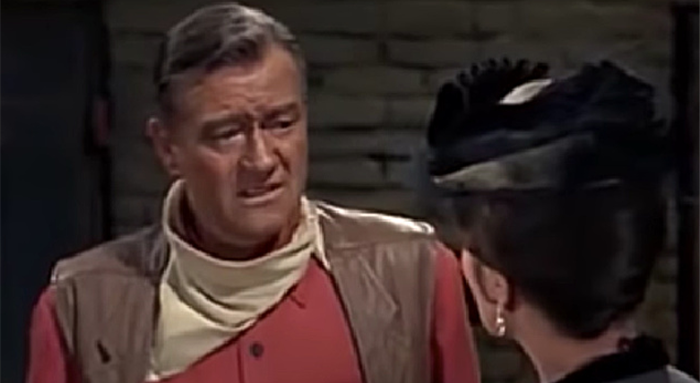The Lawless Frontier – The 1934 film was shot in less than a week at Red Rock Canyon, north of Los Angeles, and was made on a budget of around £10,000 ($11,000). Though it is relatively unknown in the huge catalogue of Wayne films, it did help him on his road to establishing himself among Hollywood’s elite – but not without a few stories to tell along the way.
His career saw him become one of Hollywood’s biggest box office draws for three decades, and in 1999 the American Film Institute chose Wayne as one of the greatest male stars of classic American cinema.
While Wayne remains a popular figure with film fans the world over, accounts from his time in Tinsel Town demonstrate the frustrations he occasionally shared with those he worked with. Among them was the fabled director John Huston.
The pair were colleagues on the 1958 film The Barbarian and the Geisha, which was among three pictures Wayne signed up for in a multi-million dollar deal with Twentieth Century Fox.
Huston, already an Oscar winner for his directing skills on The Treasure of the Sierra Madre, opted to cast Wayne in his new western after he was impressed with his work on Red River.

Set in 1856, The Barbarian and the Geisha sees Wayne’s character sent to Japan by the US government to act as the consul, but he experiences hostilities from the local authority when he arrives, before falling in love with a young geisha.
But the shooting of scenes for the film descended into chaos after a near-fatal episode saw many cast and crew left unconscious during a horror moment on set. Michael Munn’s 2001 book John Wayne: The Man Behind the Myth explored the devastating encounter.
Huston, Munn recalled, was shooting a scene in Japan where Wayne set a village alight, and loaded dead bodies onto boats to burn them. Incredibly, the line that attached the burning barge to the set broke, with the wind sending it right into local fishing boats in a small cove.
This led to the fuel boats blowing up, and in turn, saw local villagers attack the film’s Japanese cast members. Recalling his horror, Huston reportedly remembered that “a lot of people were knocked unconscious”, before thanking God that “no one was killed”.
Wayne also detailed the experience, but it affected his relationship badly with Huston. Wayne continued: “When I saw the riot begin, I ran down to the docks and began waving my hands and shouting for everyone to calm down.
“The rioters saw me, and I guess they liked John Wayne enough to stop the riot. I promised all the fishermen that I would make good their losses out of my own pocket if the studio wouldn’t.
“Well, when Huston saw and heard this, he just walked away and never said a word. He couldn’t bear the fact that he’d goofed badly and that I was the one who handled the situation.”

Later Wayne discussed his distaste for Huston, describing him as a “greatly overrated” filmmaker. Writing in the 1988 book John Wayne: Prophet of the American Way, critic Emanuel Levy noted this relationship and how it ended.
He wrote: “Wayne told reporters that ‘the most successful films I have made have been about people, not plots and backgrounds,’ and that he was ‘surprised at Huston’s attack, that all-out go for sheer beauty like a Japanese print.’
“‘I’ve endured a lot of bad scripts and bad directors,’ he said, but ‘the time comes when you gotta speak up.’ He admitted that ‘for a while I couldn’t make up my mind whether to flat quit and go home and let them sue me, or stay and give this thing a whirl.
“‘Guess I’m in so deep now I can’t back out–but the Old Duke’s not happy.’ A consummate professional, he felt the contract was binding, but he never worked again with Huston again.”
Leave a Reply